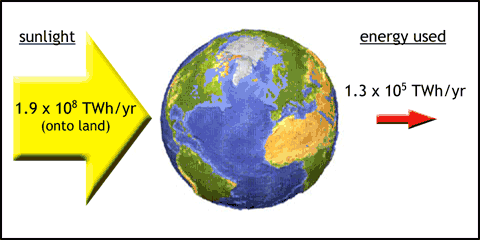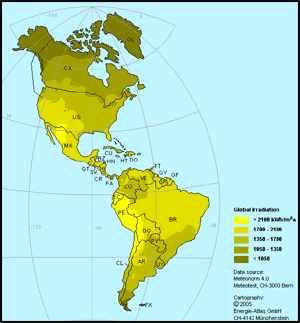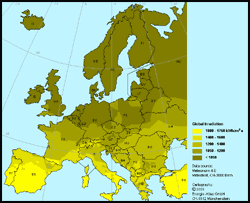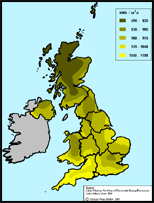


On this page we discuss the vast potential of the Sun as a key energy provider. There are also details on how much sunlight different countries receive and how this equates to the energy requirements of the whole world and the electricity demand of an example country (the USA). As the energy from the Sun is already powering the climate and our ecosystems, it doesn't seem too radical a proposal that we make further use of this free energy.
As a source of energy, solar has numerous advantages including:
The book A Solar Manifesto contains masses of detail on the economics and potential of solar energy. To see a table of a comparison of the social costs and benefits of various energy carriers click here (opens a new window).
About 1.9 x 108 TWh per year is absorbed by the land surfaces of the Earth, from a continual energy input to the upper atmosphere of 1.8 x 1017 W (a note on units and exponents is here, opens a new window). When we compare this with the total energy requirement of the human race (excluding food and wood) of 1.3 x 105 TWh/yr, we find that enough sunlight reaches the land in 6 hours to supply the human race's energy needs for one whole year (figure 1).

Or, we can limit the comparison to total world electricity consumption:
To give you an idea of how much energy this is, if we say that an average US household uses, 10,000 kWh of electricity per year, how long will it take to use 1TWh? About 100,000 years (less if you leave the heaters on a few thousand years too long).
The Sun provides us with massive amounts of free energy, but obviously some countries receive more than others. How much sunlight do different parts of the world get every year? The following figures show this (click on images to open larger versions in new windows).




Taking the USA as an example: how much sunlight would we need to supply the annual electricity demand of the US? And what minimum surface area of panels (at 100% conversion efficiency) would we need to generate this electricity?
Please note that these calculations are conservative, due to the use of the minimum level of US insolation - actual figures will be better than this in many locations.
BUT, this assumes 100% conversion efficiency of light into electricity. At a reasonable 15% conversion efficiency (typical for monocrystalline silicon solar panels), it would need 51 m2/household. Obviously increases in efficiency of the technology would be beneficial to minimise the area of panels needed, and ideally the more efficient solar panels should also be significantly cheaper than those currently on the market to stimulate widespread implementation of the technology.
This is where Synthisol Ltd fits in. Our panels will be significantly more efficient (around twice the efficiency of the best silicon panels on the market). They also won't need the enormous capital expenditure in manufacturing facilities that semiconductor-based technologies require.
The Photosynthesis page provides information on the fascinating biological process that plants use to harness sunlight in the production of molecules.
